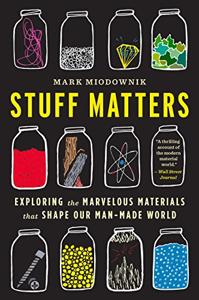
Want to learn the ideas in Stuff Matters better than ever? Read the world’s #1 book summary of Stuff Matters by Mark Miodownik here.
Read a brief 1-Page Summary or watch video summaries curated by our expert team. Note: this book guide is not affiliated with or endorsed by the publisher or author, and we always encourage you to purchase and read the full book.
Video Summaries of Stuff Matters
We’ve scoured the Internet for the very best videos on Stuff Matters, from high-quality videos summaries to interviews or commentary by Mark Miodownik.
1-Page Summary of Stuff Matters
Overview
Mark Miodownik was stabbed by a razor when he was 13 years old. Although the incident inspired him to learn more about materials, it also traumatized him. How can something so small and thin cut someone so deeply? Why do some things bend while others break? Why do certain materials look and behave the way they do?
To answer these questions, Miodownik started a project to find the materials that have made human civilization what it is today. His investigation into the materials invented throughout history helps him explain how inventions shape society.
Steel
Although metallurgy has been around for a long time, it was not understood scientifically until the 20th century. Humans spent thousands of years studying physics and astronomy, but they could not apply that knowledge to metalworkers until much later. It was during this period when humans began experimenting with steel during the industrial revolution; thus, they had no idea how iron and steel was made then.
At the end of the Stone Age, humans began to use metals. They were hard to find and difficult to mine at first, but eventually people figured out what made them so valuable: unlike flint or bone, which break when hit with a rock or another object, metals get harder when you hit them. This is because they have their own malleable flow. The Stone Age gave way to the Iron Age and humans learned how to shape metal for their needs.
Metals have a crystalline structure, which is why they can be manipulated into different shapes. Crystals are transparent and multifaceted gemstones, but metal also has this same structure. When metals take on new shapes, it’s because their atoms rearrange themselves within the crystalline form. Heating up a metal or bashing it with rock rearranges its crystalline atomic structure and allows for the creation of new shapes. A razor blade becomes dull after repeated collisions with your hair (which causes these small changes in shape), so you need to sharpen it to restore its original sharpness by rebuilding its previously destroyed crystal structure during the Iron Age (when people didn’t know anything about crystals or atoms).
Early metallurgy made a significant leap forward when people discovered they could heat malachite to produce copper. This was important because the rock previously had no value and now it did. Copper played an important role in human civilization, especially in Egypt where the pyramids couldn’t have been built without tools that were strong enough to break apart large chunks of stone.
When metalsmiths discovered the power of alloys, they took another big step forward. Alloys are stronger than pure metals because they contain mixtures of different atoms, which are more difficult to rearrange. For instance, gold is an extremely soft metal but when mixed with small amounts of copper or silver it becomes much stronger. Steel is an alloy of iron and carbon and was created by accident when iron was exposed to high heat (from coal). The result was steel—a material even stronger than bronze.
The strongest form of steel before the Industrial Revolution was created by Japanese samurai warriors. They discovered that low-carbon and high-carbon steels felt different in their hands, sounded different when struck, and looked differently. The result of this revelation was a sword with unmatched sophistication, one that could endure hard contact with other swords while remaining sharp enough to slice human flesh.
In the middle of the 19th century, inventor Henry Bessemer developed a process for making steel cheaply and in large quantities. It involved blowing air through molten iron to remove impurities. The process wasn’t always reliable, though, because it could produce brittle iron or good quality steel depending on conditions. Eventually he perfected the process so that both outcomes were equally likely when using his method.





